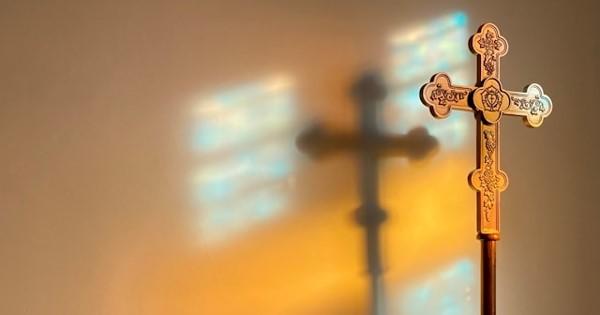The latest issue of The Way, the spirituality journal published by the Jesuits in Britain, is a tribute to the late Philip Endean SJ, who died in September 2023. In this newly translated article, which appears in that issue, Philip explores Ignatius’s presentation – or presentations – of the cross in the Spiritual Exercises.
According to the Christian tradition, our attitude before the evil in our world and our experience has to be paradoxical. There is evil, structural evil, evil rooted even in our very means of existence. We cannot change this by our own efforts. But the gospel tells us that God can do something; what is evil, without ceasing to be evil, is surrounded by, or contained within, a grace that is at once creative, liberating and eschatological: a promise that we receive through the story of Jesus Christ, crucified and resurrected, as the first and definitive sign of the Kingdom he preached during his life.
José García de Castro has shown us the links between the Ignatian formulations about the cross and the typical forms of the Middle Ages. Instead of the Pantocrator, their common piety emphasised the humanity of Jesus Christ; in the face of the bubonic plague there developed a profound sense of the presence of Christ in human suffering. And it also spoke of dolorismo, the glorification of suffering.[1]
However, beyond the evident textual links between the Ignatian and Franciscan traditions, it must be added that in Ignatius and in the Christian gospel there are other things that come into play. As difficult as it is, we are heretics, at least implicitly, if we act as though we had to choose between the Pantocrator and the suffering servant. We believe in Christianity, not in Jesusism. In a way that cannot be understood, the truth is expressed by the two images together, though exceeding both. The divinity is hidden but cannot be removed.
In the St John Passion by Johann Sebastian Bach, Pilate asks the crowd if he must liberate Jesus or Barabbas, the bandit. They cry, ‘not this man but Barabbas’, and Pilate orders that Jesus be scourged. The music tangibly reflects the lashes. This meditation follows immediately:
Consider, my soul, with anxious delight, with bitter pleasure and a heart partly oppressed, that your highest good depends on Jesus’ sorrow, how for you from the thorns that pierce him heavenly flowers blossom! You can gather so much sweet fruit from his wormwood therefore look unceasingly towards him!
The aria that follows continues this same theme: ‘Ponder well how his back bloodstained all over is like the sky, where after the deluge from our flood of sins has abated there appears the most beautiful rainbow as a sign of God’s mercy!’[2] Bach’s music indicates something of the theological complexity of the fourth gospel, according to which the cross, in a sense hidden to those from outside but not to believers, is a throne. There is a lot of grief, blood and pain. But on a deeper level there is not pure disaster but rather triumph. God is working, even glorifying Godself here too.
In any gathering of good, committed and conscientious people, a confrontation with what is negative in our lives – the enormous problems of Latin American societies, the crimes of Auschwitz, the suffering of the victims of Hiroshima, the experience of the battles of the First World War – could descend into the glorification of suffering. This can lead us into a perverse celebration, a type of masochism sometimes expressed and legitimated in religious terms but which, in the end, does not lead to transformation. The fascination with evil becomes a trap for us; and the cross of Jesus Christ ceases to be good news.
The grace of the gospel – and grace as it was understood by St Ignatius – insists that the evil in our lives, both personal and structural, must be taken seriously. But at the same time, we have to believe that evil and sin do not limit reality or God’s work. Even if we despoil the earth, according to the English Jesuit poet Gerard Manley Hopkins, ‘there lives the dearest freshness deep down things’.[3] Perhaps we complicate the action of God, but we do not hinder it. Ignatius encourages us in this way in,
… an exclamation of wonder and surging emotion, uttered as I reflect on all creatures and wonder how they have allowed me to live and have preserved me in life …. Likewise, the heavens, the sun, the moon, the stars, and the elements; the fruits, birds, fishes, and animals. And the earth: How is it that it has not opened up and swallowed me, creating new hells for me to suffer in forever? (Exx 60)
A spirituality of the cross is not Christian unless there is something afterwards. Christianity is not a cult of death and suffering. It demands of us a faith that tells us the power of God is always active, even in our greatest catastrophes, giving us, freely and beyond our merit, the possibility of forgiveness and new life. Here is the radical abnegation which allows us to appropriate the gift that comes from God our Lord alone.
It is easy to speak of a theology of the cross, above all for some in the Lutheran tradition. However, the symbol of the cross in the Exercises is multivalent: it has more than one meaning. Perhaps it would be better to avoid the word theology completely. Or rather to say that there are many forms of theology; that a wise theology is always one of humble reticence; that theology does not pretend to understand the mysteries of God’s grace.
The word theology itself stubbornly implies that it is an idea, a concept that specifies reality, that has a permanent validity. And this does not correspond with the graces of the Ignatian Exercises. There is a process which arrives at a whole; the end does not make sense except in the context of what has happened before. The reality cannot be described using a formulation that holds eternal meaning. We are temporal creatures. Reality has to be lived, and it can only be appropriated in successive phases. It can be only be discovered on foot. There is an Ignatian process to the graces in which the cross of Christ inspires us by a diversity of means. In what follows, I would like to describe something of this diversity, and at the end to offer some reflections about the whole.
The cross in the three phases of the Exercises
There is an ancient – and, as far as I know, anonymous – formula that clearly summarises the dynamic of the Exercises. In the First Week, the deformed is reformed; in the Second, the reformed is conformed; in the Third and the Fourth, the conformed is confirmed. Perhaps it sounds better in Latin: deformatum reformare, reformatum conformare, conformatum confirmare. The same thing can be said in the traditional terms of the three ways: purgative, illuminative and unitive (although the third stage is understood here in a slightly novel way). In all three, the cross plays a definitive role, while of course being the same cross. However its meaning is always changing according to the development of the dynamic: in the First Week, the cross indicates the forgiveness and victory of God; in the Second it indicates the horizon within which the election of a future life can be made; in the Third and Fourth there is an identification with Christ crucified and, after the resurrection, a share in his own joy and the consolation of his friends. However, in one way or other, there is always a complex insistence upon the positive significance of the cross. I will try to sketch these characteristics in the successive phases of the Exercises.
In the First Week, the cross appears for the first time suddenly and dramatically, as a counterweight to the three sins of the angels, of Adam and Eve, and of the hypothetical sinner. We are not accused of having crucified Christ, but make a colloquy:
Imagine Christ our Lord suspended on the cross before you, and converse with him in a colloquy: How is it that he, although he is the Creator, has come to make himself a human being? How is it that he has passed from eternal life to death here in time, and to die in this way for my sins? In a similar way, reflect on yourself and ask: What have I done for Christ? What am I doing for Christ? What ought I to do for Christ? (Exx 53)
Here, the cross presents itself as symbol of forgiveness and renewed life more than of punishment. The accent is placed not on the sins themselves, but on the ongoing grace of God in spite of those sins. In the triple colloquy, it is not profound repentance that is sought, but interior knowledge. It is necessary to learn from this experience, so that the election that comes afterwards is made according to a true and accurate interpretation of the situation of a person in a world of sin.
The petitions characteristic of the Second Week invite us to a passionate love towards the poor and oppressed Jesus – but always under a condition: ‘if only I can do this without sin on anyone’s part and without displeasure to the Divine Majesty’ (Exx 147). I doubt that the situation that Ignatius specifies here could really happen, but people more holy and wise than I do not see the logical and psychological problem that I see here – something that I tried to discuss a few years ago in an article in English.[4] In any case, it is very clear and explicit that the desire for the negative with Christ is relativised. It is not an unconditional goal of the process. The process is orientated towards what God wants, to what is for God’s greater glory and service.
Although the prayer of the Third Week is extremely dry and austere, it must be emphasised that the Third Week is a counterpoint to the Fourth. There is a parallelism in the presentation of the points confirming the testimony of many directors: that without it the prayer of the Third Week could degenerate into the glorification of suffering that comes from the enemy, even if perhaps sub specie lucis. The grace of the cross is preparatory to a grace which is positive, transforming, that springs from the true and most holy effects of the resurrection, even in this earthly life. It is here, finally, that the mission is realised.
Jesus carrying his cross
The sources in the gospels narrate the passion and the cross of Christ, and the interpretation of the facts is different in each. In the synoptic tradition, the cross is too heavy for a man already debilitated by horrible torture, and the soldiers oblige another, Simon of Cyrene, to carry it for him. In Luke, Jesus dies saying, ‘Father, into your hands I commend my spirit’ (Luke 23:46), while the death in Matthew and Mark is a total failure: Jesus dies crying, ‘My God, my God, why have you forsaken me?’ (Matthew 27:46; Mark 15:34) The tradition has taken much from these visions of the passion of Christ.
For many people, it is important that Jesus felt desperation and even the impotence that they may have felt throughout their own lives. In Lutheran theology, this form of religious experience has been radicalised, and an extremely paradoxical – frankly incoherent – doctrine of God has been constructed. The death of Jesus reveals to us that our image of God as omnipotent, as the Lord of all creation, is false. The true God is, in essence, weak. The idea that God sustains and maintains all things with an omnipotent hand is, according to some authors – I think especially of the contemporary German theologian Jürgen Moltmann – revealed now as an infantile fantasy, a mere projection of the relations of power that usually act among us. According to this way of thinking, which has also been taken up in Latin American liberation theology, the gospel has been given to teach us that the true God is not like this. The true God, silent, mysterious, is completely different from human powers and thus, although only in a hidden and enigmatic form, liberates us.
But there is another testament in the gospels. In John, Jesus – who presents himself as the ‘I AM’ of the divine name – carries his own cross to Golgotha and dies after a typically ambivalent phrase: ‘it is finished’ (John 19:30). Those who have rejected him can hear the phrase as an expression of failure but, in reality, for those who have received him and have been illuminated by the power of God, it can only be interpreted as a cry of triumph. The Son has been glorified and his beloved disciples are reborn in the blood and water that flow from his side; they also have Mary as mother and enter into the same relation that Jesus has with his Father.
Ignatius, perhaps following the movement that formed what we technically call the biblical canon, structures his spirituality principally according to the vision of the fourth Gospel. The Jesus whom Ignatius met at La Storta is carrying his own cross; the Father himself puts Ignatius with him, just as Ignatius had asked Mary to be put with her Son. The will of God is that Ignatius should ‘serve us’.[5] Clearly, Ignatius did not directly reject the vision of Luther or Moltmann. It can be imagined that he would counsel us to praise such theologies, as in the Rules for Thinking and Feeling with the Church, where he encourages us to praise all forms of piety that are not admitted within his own way of proceeding. But for him, the negative is always contained with the positive. Sin is surrounded by pardon already achieved; the divinity hides itself during the passion but is in no way destroyed, much less annihilated.
Even though we have to take seriously what is negative in this world, it never defines reality. In the dynamic and the process of the graces of the Exercises, the paradoxes can be lived such that they are not senseless contradictions, as it appears when we present theological truths about the state of the world. It is not necessary to choose between a positive vision that trivialises the evil and grief of the world and a negative vision involved so intensely and obsessively in darkness that the light is not seen when it comes. It is necessary to live the process and interaction. But ultimately the cross signifies the victory of God; there is more at play here than death.
In the beginning of his formative experiences in Manresa, the pilgrim Ignatius felt for the first time very strong fluctuations in his soul:
… he began to undergo great variations in his soul, finding himself sometimes so much without relish that he found no savour either in praying or in hearing mass or in any other prayer he made, and at other times something coming over him pulling him towards so much the opposite, and so suddenly, that it seemed someone had taken away the sadness and the desolation from him like a person taking a cape from someone’s shoulders. And at this point he began to be frightened at these variations, which he had never previously experienced, and to say to himself: ‘what new life is this we’re beginning now?’ (Autobiography, n.21)
At this time none of the spiritual people could help him individually, except a woman who wished that ‘my Lord Jesus Christ would appear to him one day’, a person who did not explain or clarify much, but who orientated him towards the Creator and Lord himself, so that he felt and interiorly relished the things for themselves from within.[6]
Those who receive the Exercises, unless there are problems (Exx 6), also find themselves in a strange world; they begin a ‘new life’ in which the conventional truths of the catechism and its Christian formation are not enough. They enter into a creative obscurity, where they have to learn to distinguish between good and evil, between feelings of healthy guilt and guilt that is merely destructive, between a fruitful authentic devotion to God crucified and an obsession with negativity that – although still located exteriorly in the Church – little by little becomes deaf to the salvific call of the King of life. God himself has to teach exercitants ‘in the same way that a teacher treats a child’ (Autobiography, n.27). But we have also to be ever conscious that the sin of the world will never prevail against the goodness of God. The light shines in the darkness and the darkness will not overcome it.
In his presentation of the cross of the Lord – or, better, his presentations – Ignatius wants us to be existentially confronted with the negative possibilities that ‘new life’ opens to us. But he also orientates us, discreetly but firmly, so that we experience, ever more deeply, that evil is contained within eternally triumphant grace. Isaiah writes: ‘So shall my word be that goes out from my mouth; it shall not return to me empty, but it shall accomplish that which I purpose, and succeed in the thing for which I sent it’ (55:11). The graces of the Exercises make us live according to this conviction of faith; in order to help us to receive these graces, Ignatius presents us with the symbol of the cross in a very precise and original way. O that we would walk as pilgrims on the earth, surrounded ever more deeply by this mysterious reality of the love of God, as God himself wants to lead us!
Philip Endean SJ had a long association with The Way and was its editor between 1994 and 1996, and again between 2001 and 2007. Before his death in September 2023 he worked at the Centre Sèvres (now Facultés Loyola), the home of the Jesuit faculties in Paris.
The original Spanish version of this article appeared as ‘La cruz y las gracias de los Ejercicios’, Apuntes Ignacianos 61 (2011), 102–110. The Way is grateful for permission to publish this translation by Philip Harrison SJ, which appeared in The Way, 63/2 (April 2024), 9–17; and Thinking Faith is grateful, in turn, to The Way. Visit theway.org.uk to find out more and subscribe.
[1] See José García de Castro Valdés, ‘La Pasión en las pasiones tardomedievales’, Apuntes Ignacianos, 61 (2011), 3–26.
[2] Johann Sebastian Bach, St John Passion, BWV 245, part 1, 19, bass arioso and 20/21a, tenor aria and recitative. Translation from https://www.bach-cantatas.com/Texts/BWV245-Eng3.htm.
[3] Gerard Manley Hopkins, ‘God’s Grandeur’, in The Poetical Works of Gerard Manley Hopkins, edited by Norman H. MacKenzie (Oxford: Clarendon, 1990), 139.
[4] See Philip Endean, ‘On Poverty with Christ Poor’, The Way, 47/1–2 (January/April 2008), 47–66.
[5] ‘… he said that he seemed to see Christ with the cross on his shoulder. And the eternal Father was
close by, saying, “I want you to take this person as your servant”. And thus Jesus took him, and said, “I want you to serve us”.’ Diego Laínez, MHSJ FN 2, 133. Quoted by Philip Endean in a footnote to Autobiography, n.96 (Personal Writings, 376) [Ed].
[6] Autobiography, n.37; compare Exx 2, 15.






